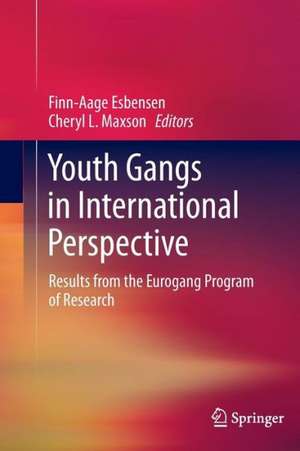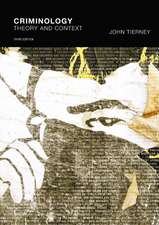Youth Gangs in International Perspective: Results from the Eurogang Program of Research
Editat de Finn-Aage Esbensen, Cheryl L. Maxsonen Limba Engleză Paperback – 2 mar 2014
Youth Gangs in International Perspective provides a needed corrective by offering significant studies from across Europe, as well as Trinidad-Tobago and Israel. The book spans the diversity of the field in the cultural and scholarly traditions represented and methods used, analyzing not only the social processes under which gangs operate and cohere, but also the evolution of the research base, starting with the Eurogang Program’s definition of the term youth gang. Cross-national and gender issues are discussed, as are measurement concerns and the possibility that the American conception of the youth gang is impeding European understanding of these groups. Among the topics covered:
- Gang dynamics through the lens of social identity theory.
- Defining gangs in youth correctional settings.
- Gang gender composition and youth delinquency.
- From Stockholm: a holistic approach to gang intervention.
- Gang membership as a turning point in the life course.
- The impact of globalization, immigration, and social process on neo-Nazi youth gangs.
Filling a critical gap in the literature, Youth Gangs in International Perspective will find a wide audience among criminologists, policymakers specializing in youth crime, and researchers and graduate students in criminology, political science, and youth studies.
| Toate formatele și edițiile | Preț | Express |
|---|---|---|
| Paperback (1) | 946.24 lei 6-8 săpt. | |
| Springer – 2 mar 2014 | 946.24 lei 6-8 săpt. | |
| Hardback (1) | 952.26 lei 6-8 săpt. | |
| Springer – 12 dec 2011 | 952.26 lei 6-8 săpt. |
Preț: 946.24 lei
Preț vechi: 1153.95 lei
-18% Nou
Puncte Express: 1419
Preț estimativ în valută:
181.08€ • 196.63$ • 152.11£
181.08€ • 196.63$ • 152.11£
Carte tipărită la comandă
Livrare economică 23 aprilie-07 mai
Preluare comenzi: 021 569.72.76
Specificații
ISBN-13: 9781489991805
ISBN-10: 1489991808
Pagini: 332
Ilustrații: X, 322 p.
Dimensiuni: 155 x 235 x 17 mm
Greutate: 0.47 kg
Ediția:2012
Editura: Springer
Colecția Springer
Locul publicării:New York, NY, United States
ISBN-10: 1489991808
Pagini: 332
Ilustrații: X, 322 p.
Dimensiuni: 155 x 235 x 17 mm
Greutate: 0.47 kg
Ediția:2012
Editura: Springer
Colecția Springer
Locul publicării:New York, NY, United States
Public țintă
ResearchCuprins
Finn-Aage Esbensen and Cheryl L. Maxson: The Eurogang Program of Research and Multi-method Comparative Gang Research: Introduction.-Definitional issues in the comparative context.-Kristy N. Matsuda, Finn-Aage Esbensen & Dena C. Carson: Putting the “Gang” in “Eurogang”: Characteristics of Delinquent Youth Groups by Different Definitional Approaches.-Judith Aldridge, Juanjo Medina-Ariz & Robert Ralphs: Counting Gangs: Conceptual and Validity Problems with the Eurogang Definition.-Hannah Smithson, Leanne Monchuk & Rachel Armitage: Gang Member: Who Says? Definitional and Structural Issues.-Frank van Gemert: Five Decades of Defining Gangs in the Netherlands: The Eurogang Paradox in Practice.-David C. Pyrooz, Andrew M. Fox, Charles M. Katz & Scott H. Decker: Gang Organization, Offending, and Victimization: A Cross National Analysis.-Cheryl L. Maxson: Betwixt and Between Street and Prison Gangs: Defining Gangs and Structures in Youth Correctional Settings.-Group processes in the comparative context.-Karen Hennigan & Marija Spanovic: Gang Dynamics Through the Lens of Social Identity Theory.-Emma Alleyne & Jane L. Wood, Gang Membership: The Psychological Evidence.-Chris Melde & Finn-Aage Esbensen: The Onset of (Euro)Gang Membership as a Turning Point in the Life Course.-Dana Peterson & Dena C. Carson: The Sex Composition of Groups and Youths’ Delinquency: A Comparison of Gang and Non-gang Peer Groups.-Revital Sela-Shayovitz: The Impact of Globalization, Migration, and Social Group Processes on Neo-Nazi Youth Gangs.-Jan Dirk de Jong: Typically Moroccan? A group dynamic explanation of nuisance and criminal behavior.-Gang depictions in non-American contexts.-Maria Libak Pedersen & Jonas Markus Lindstad: The Danish gang joining project: Methodological issues and preliminary results.-Amir Rostami & Fredrik Leinfelt, The Stockholm Gang Intervention and Prevention Project (SGIP): Introducing a Holistic Approach to Gang Enforcement .-Frank M. Weerman: Are the Correlates and Effects of Gang Membership Sex-Specific? Troublesome Youth Groups and Delinquency among Dutch Girls.- Future Directions.-Malcolm W. Klein: The Next Decade of Eurogang Program Research.-Cheryl L. Maxson & Finn-Aage Esbensen: The Intersection of Gang Definition and Group Process: Concluding Observations.
Recenzii
From the reviews:
“This book will be of interest to scholars who are pursuing a broader understanding of gangs around the world. … The present volume features studies of group processes while also addressing definitional issues and research methods. … this book is further testimony to the excellent contributions they are making toward understanding gangs around the world … . The plethoras of insights the assembled scholars provide are of enormous value in the ever-growing gang literature.” (James C. Howell, Criminal Law and Criminal Justice Books, July, 2012)
“This book will be of interest to scholars who are pursuing a broader understanding of gangs around the world. … The present volume features studies of group processes while also addressing definitional issues and research methods. … this book is further testimony to the excellent contributions they are making toward understanding gangs around the world … . The plethoras of insights the assembled scholars provide are of enormous value in the ever-growing gang literature.” (James C. Howell, Criminal Law and Criminal Justice Books, July, 2012)
Textul de pe ultima copertă
As a steady source of juvenile delinquents and an incubator for future adult offenders, the youth gang has long been a focus of attention, from their origins and prevalence to intervention and prevention strategies. But while delinquent youth form gangs worldwide, youth gang research has generally focused on the U.S.
Youth Gangs in International Perspective provides a needed corrective by offering significant studies from across Europe, as well as Trinidad-Tobago and Israel. The book spans the diversity of the field in the cultural and scholarly traditions represented and methods used, analyzing not only the social processes under which gangs operate and cohere, but also the evolution of the research base, starting with the Eurogang Program’s definition of the term youth gang. Cross-national and gender issues are discussed, as are measurement concerns and the possibility that the American conception of the youth gang is impeding European understanding of these groups. Among the topics covered:
Filling a critical gap in the literature, Youth Gangs in International Perspective will find a wide audience among criminologists, policymakers specializing in youth crime, and researchers and graduate students in criminology, political science, and youth studies.
Youth Gangs in International Perspective provides a needed corrective by offering significant studies from across Europe, as well as Trinidad-Tobago and Israel. The book spans the diversity of the field in the cultural and scholarly traditions represented and methods used, analyzing not only the social processes under which gangs operate and cohere, but also the evolution of the research base, starting with the Eurogang Program’s definition of the term youth gang. Cross-national and gender issues are discussed, as are measurement concerns and the possibility that the American conception of the youth gang is impeding European understanding of these groups. Among the topics covered:
- Gang dynamics through the lens of social identity theory.
- Defining gangs in youth correctional settings.
- Gang gender composition and youth delinquency.
- From Stockholm: a holistic approach to gang intervention.
- Gang membership as a turning point in the life course.
- The impact of globalization, immigration, and social process on neo-Nazi youth gangs.
Filling a critical gap in the literature, Youth Gangs in International Perspective will find a wide audience among criminologists, policymakers specializing in youth crime, and researchers and graduate students in criminology, political science, and youth studies.
Caracteristici
Explore Youth Gangs outside of the United States
Provides a consistent language and framework for comparing gangs across countries
Examines youth gangs from an interdisciplinary perspective, from risk factors and society causes to intervention and prevention
Includes supplementary material: sn.pub/extras
Provides a consistent language and framework for comparing gangs across countries
Examines youth gangs from an interdisciplinary perspective, from risk factors and society causes to intervention and prevention
Includes supplementary material: sn.pub/extras












